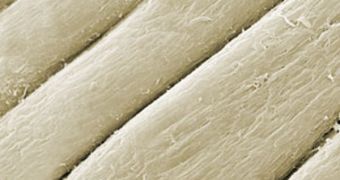Tendons are stretches of tissue in our bodies that are absolutely essential for our ability to move. They are made of a very special type of cells, which give them advanced properties, such as being able to resist without breaking under huge strains. But the downside is that, once ruptured, tendons do not heal easily, and often scars remain. These severely impede the function of that particular tendon, leading to a significant decrease in the number of ways the tissue can be used, Chemistry World reports.
Now, Japanese researchers believe they may have discovered a solution to this problem. Rather than struggling to stitch the original tendon back, and revert it to its initial use without being fully healed, they advocate replacing it with an artificial one. Just recently, they managed to conclude work on such a device, which is a 3D replacement tendon made entirely out of fibrin gel. The new method reportedly works better than any modern tissue grafts procedures, or artificial prosthetics, which are currently the norm in treating ruptured or severed tendons. The real innovation here, they underline, is the fact that the new device works in three dimensions, exceeding previously-imposed 2D limitations.
What the Osaka University team did was to essentially create a gel that encompasses a 3D pattern of cells that are of the same type as the ones found in the natural tendon tissue. According to team leader Takuya Matsumoto, this new tool may prove to be extremely suitable for reproducing tendons in vitro settings, inside the tightly-controlled confines of scientific labs. The biocompatible fibrin gel was produced from bone marrow cells that were cultured in a very specific manner. The gel was then stretched as cells were growing, so as to produce the 3D structure. The researchers also learned that they could control the way cells grew and multiplied by simply varying the amount of strain applied to the gel while stretching it.
“The cell and matrix pattern we have achieved will be effective for shortening the regeneration period of tissue,” Matsumoto says. “The use of strain to control the proliferation and differentiation of the cells is clever,” mentions University of Manchester biomaterials expert Brian Saunders. However, he cautions that this proof-of-principle needs much more research before a human therapy can be extracted from it, and applied at a large scale. The Japanese team estimates that the technology could become available to the general public within less than a decade.

 14 DAY TRIAL //
14 DAY TRIAL //